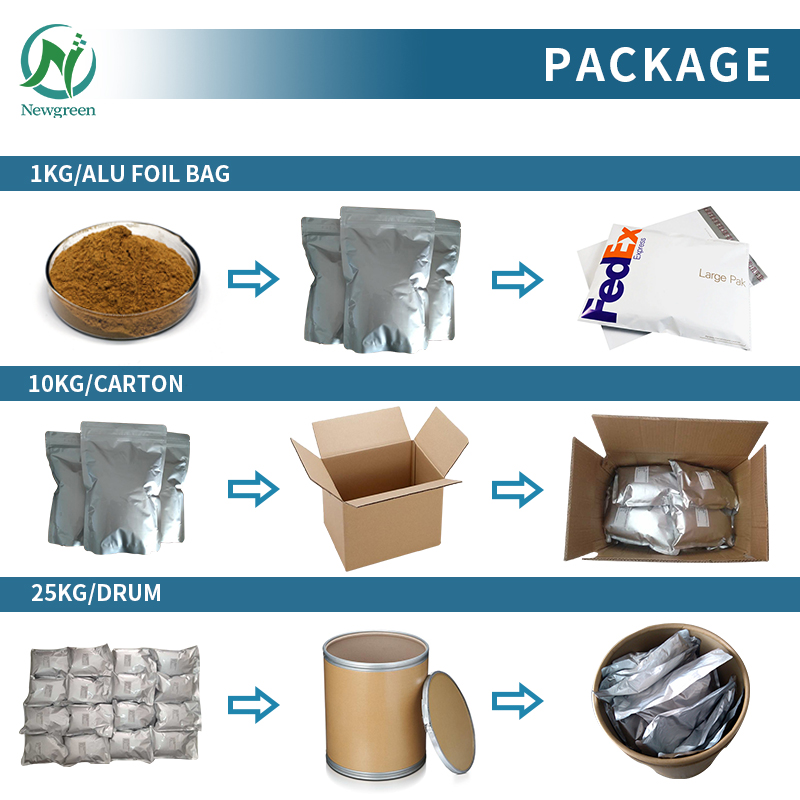N-Acetylneuraminic acid powder Manufacturer Newgreen N-Acetylneuraminic acid Supplement

Product Description
N-acetylneuraminic acid (NANA, Neu5Ac) is a major component of glycoconjugates, such as glycolipids, glycoproteins, and proteoglycans (sialoglycoproteins), which confer the characteristic of selective binding of glycosylated components. Neu5Ac is used to study its biochemistry, metabolism and uptake in vivo and in vitro. Neu5Ac can be used in the development of nanocarriers.
COA
| Items | Specifications | Results | |
| Appearance | White powder | White powder | |
| Assay |
|
Pass | |
| Odor | None | None | |
| Loose Density(g/ml) | ≥0.2 | 0.26 | |
| Loss on Drying | ≤8.0% | 4.51% | |
| Residue on Ignition | ≤2.0% | 0.32% | |
| PH | 5.0-7.5 | 6.3 | |
| Average molecular weight | <1000 | 890 | |
| Heavy Metals(Pb) | ≤1PPM | Pass | |
| As | ≤0.5PPM | Pass | |
| Hg | ≤1PPM | Pass | |
| Bacterial Count | ≤1000cfu/g | Pass | |
| Colon Bacillus | ≤30MPN/100g | Pass | |
| Yeast & Mold | ≤50cfu/g | Pass | |
| Pathogenic Bacteria | Negative | Negative | |
| Conclusion | Conform with specification | ||
| Shelf life | 2 years when properly stored | ||
Function
1. Improve baby's intelligence and memory
N-Acetylneuraminic acid is an important building block of gangliosides in the brain. The content of sialic acid in the nerve cell membrane is 20 times that of other cells. Because the transmission of brain information and the conduction of nerve impulses must be realized through synapses, and N-Acetylneuraminic acid is a brain nutrient that acts on brain cell membranes and synapses, so N-Acetylneuraminic acid can promote The development of memory and intelligence. Studies have found that increasing the content of N-Acetylneuraminic acid in the breastfeeding diet will increase the content ofN-Acetylneuraminic acid in the baby's brain, and the expression level of genes related to learning will also increase, thereby enhancing its learning and memory abilities. In babies, the content of N-Acetylneuraminic acid is only 25% of that in breast milk.
2. Anti-senile dementia
N-Acetylneuraminic acid has a protective and stabilizing effect on nerve cells. After the protease located on the surface of nerve cell membrane is combined with N-Acetylneuraminic acid, it can not be degraded by extracellular protease. Some neurological diseases, such as early senile dementia and schizophrenia, will reduce the N-Acetylneuraminic acid content in blood or brain, and after recovery from drug treatment, theN-Acetylneuraminic acid content will return to normal, which indicates that N-Acetylneuraminic acid participates in the metabolic process of nerve cells .
3. Anti-recognition
Between molecules and cells, between cells and cells, and between cells and the outside world, the N-Acetylneuraminic acid at the end of the sugar chain can serve as a recognition site or mask the recognition site. The N-Acetylneuraminic acid linked to the end of the glycosides through glycosidic bonds can effectively prevent some important antigenic sites and recognition marks on the cell surface, thereby protecting these saccharides from being recognized and degraded by the surrounding immune system.
Applications
1. N-Acetylneuraminic acid is used in the production of various neuraminidase inhibitors, glycolipids and other synthetically derived bioactive products. Can be used as a nutritional supplement.
2. N-Acetylneuraminic acid plays an important role in dietary supplement as a glyconutrient. It regulates blood protein half-life, acidification, neutralization of various toxins, cell adhesion and glycoprotein lysis protection. Can be used as a food additive.
3. N-Acetylneuraminic acid can be used as a starting reagent for the synthesis of biochemical derivatives of drugs. Can be used as a cosmetic.
Package & Delivery



















